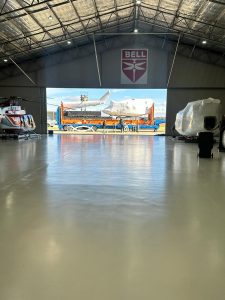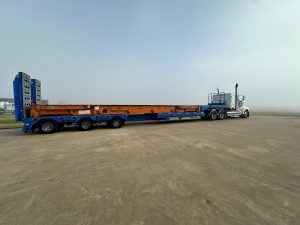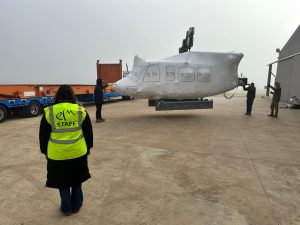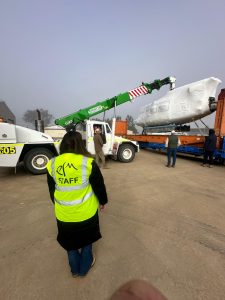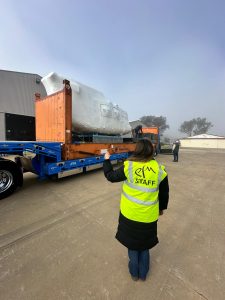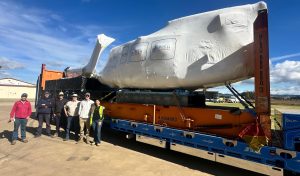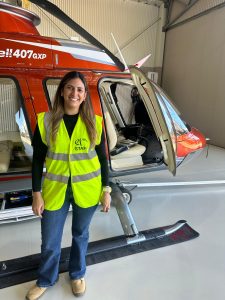A six-ton aircraft, out-of-gauge clearances, and one narrow window to get it done, or miss the shipping deadline.
At 3:00 AM, a low-loader left Sydney in darkness and thick fog, bound for a remote corner of New South Wales. The cargo waiting for it? A Bell 412 helicopter. Not flying out, but being moved by road.
It was a move built on precision, timing, and zero margin for delay. The helicopter was too large to move freely, too delicate for mistakes, and too expensive to hold up at the port. It had to be picked up, packed, and delivered before the afternoon permit cut-off. If the transporter wasn’t back by 3:00 PM, the shipment would miss its port slot, triggering a domino effect of delays.
And the fog wasn’t helping.
The Job: One Helicopter, Seven Major Risks
This wasn’t just a big load, it was a complex, high-stakes operation. Moving a Bell 412 helicopter by road meant navigating seven very real risks:
- Out-of-Gauge Cargo: The load exceeded height (+64.5 cm) and width (+28.5 cm) limits, requiring a special permit and a strict return window to remain road-compliant.
- Narrow Time Window: With a 3:00 PM permit cut-off, the team had just a few hours to complete the lift, pack, documentation, and departure, or miss the shipping slot entirely.
- Zero Backup Option: There was no alternate time slot at port. A delay would’ve meant days, not hours, of rescheduling and added cost.
- Dense Fog Conditions: Visibility dropped to 50 metres during early transit, complicating approach and positioning at the pickup site.
- Delicate Aircraft Components: The main fuselage and tail couldn’t tolerate shock or metal-to-metal contact. Every lift, set, and strap had to be precise.
- Tight Loading Margins: The fuselage was placed just six inches from the rear edge of the flat rack, a high-stakes move requiring pinpoint accuracy.
- Live Documentation: Marine survey reports and shipping paperwork had to be submitted in real time before the load reached the terminal. One error, one late form, and the shipment would’ve been held back.
Each risk on its own could have caused delays. Together, they made the move an exercise in coordination, timing, and technical execution, where every part had to go right.
08:50am. One Flat Rack. Zero Room for Error.
The EFM team and crane crew arrived on site just before 9:00 AM. Safety briefing done. End gates raised. Lift ready.
Soft slings went on. The fuselage rose. Guided with precision, it came down onto the rack, six inches from the rear edge. Perfectly balanced. No shift. No damage.
Then came the crates:
Essential components like doors, stabilisers, and swashplates were carefully loaded and stacked. The landing gear was mounted on top, and the tail section followed, bolted and lashed securely in place.
Everything was checked. Then checked again. Meanwhile, the documentation crew submitted photos, measurements, and the final survey report, while the load was still in motion.
312 Kilometres. 3 Hours. One Permit That Wouldn’t Wait.
At 11:55 AM, the load started its journey.
The next stage was a measured race against the clock with a vehicle escort, live paperwork updates, and one shot at hitting the terminal on time.
Every kilometre was tracked with updates that were sent as the truck navigated rural highways, city traffic, and the countdown to a 3:00 PM cut-off.
Meanwhile, final documentation, including the marine survey and compliance photos, was submitted while the load was still en route. A late form or a single error could have blocked entry.
At 2:57 PM, the truck cleared the terminal gate. Three minutes to spare. No delays. No second chances needed.
“It’s not every day you move a helicopter that can’t fly,” said Luisa Giraldo, Senior Account Manager., EFM Global “Everything had to go right the first time. From load planning and permits to lashing and paperwork, there was no buffer. The team nailed it.”
- Morning fog
- In the warehouse
- Transport arriving
- Loading the helicopter
- With pinpoint accuracy
- Gettting ready for transit
- Good to go
- On the move
- Job done
Bell 412 Road Move: By the Numbers
- Distance moved: 312 km
- Cargo: Bell 412 fuselage, tail, landing gear, and 6 crates
- Clearance to end gate: 15.2 cm (6″)
- Visibility at pickup: <50 m in early fog
- Loading window: 2 hrs, 5 mins
- Permit cut-off: 3:00 PM
- Transport departure from site: 11:55 AM
- Straps used: 8 (4 on frame, 4 directly on fuselage)
- Rework required: 0
When every detail matters, it helps to have a logistics partner who’s done it before. Let’s talk about your next move.


